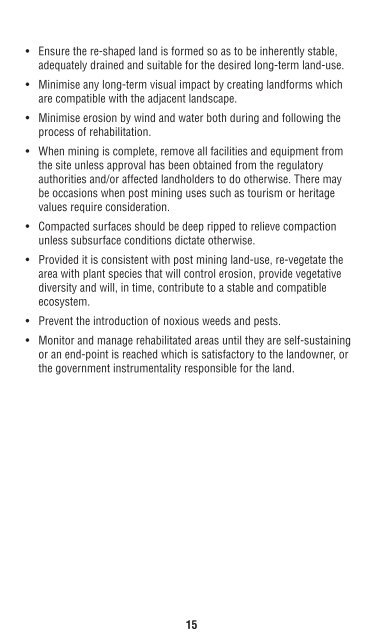Mine Rehabilitation Handbook - Mining and Blasting
Mine Rehabilitation Handbook - Mining and Blasting
Mine Rehabilitation Handbook - Mining and Blasting
Create successful ePaper yourself
Turn your PDF publications into a flip-book with our unique Google optimized e-Paper software.
• Ensure the re-shaped l<strong>and</strong> is formed so as to be inherently stable,<br />
adequately drained <strong>and</strong> suitable for the desired long-term l<strong>and</strong>-use.<br />
• Minimise any long-term visual impact by creating l<strong>and</strong>forms which<br />
are compatible with the adjacent l<strong>and</strong>scape.<br />
• Minimise erosion by wind <strong>and</strong> water both during <strong>and</strong> following the<br />
process of rehabilitation.<br />
• When mining is complete, remove all facilities <strong>and</strong> equipment from<br />
the site unless approval has been obtained from the regulatory<br />
authorities <strong>and</strong>/or affected l<strong>and</strong>holders to do otherwise. There may<br />
be occasions when post mining uses such as tourism or heritage<br />
values require consideration.<br />
• Compacted surfaces should be deep ripped to relieve compaction<br />
unless subsurface conditions dictate otherwise.<br />
• Provided it is consistent with post mining l<strong>and</strong>-use, re-vegetate the<br />
area with plant species that will control erosion, provide vegetative<br />
diversity <strong>and</strong> will, in time, contribute to a stable <strong>and</strong> compatible<br />
ecosystem.<br />
• Prevent the introduction of noxious weeds <strong>and</strong> pests.<br />
• Monitor <strong>and</strong> manage rehabilitated areas until they are self-sustaining<br />
or an end-point is reached which is satisfactory to the l<strong>and</strong>owner, or<br />
the government instrumentality responsible for the l<strong>and</strong>.<br />
15<br />
5 STANDARD REHABILITATION<br />
The Australian minerals industry includes major open-cut <strong>and</strong> strip<br />
mines, underground long wall <strong>and</strong> hard rock ore mines, s<strong>and</strong> <strong>and</strong> gravel<br />
extraction, dredging operations <strong>and</strong> gemstone mining. Each mine will<br />
have particular characteristics that will influence the procedures adopted<br />
in the rehabilitation program. These characteristics may be obvious but<br />
critical differences are often only identified by careful investigation. The<br />
proposed post mining l<strong>and</strong>-use will also influence the procedure <strong>and</strong> the<br />
plant species used for rehabilitation.<br />
This section outlines the basic rehabilitation practices which, with<br />
appropriate modification, will apply to most disturbed areas. Section 6<br />
discusses additional rehabilitation procedures for particular categories<br />
of problem sites.<br />
5.1 Making Safe<br />
After planning, the first step in rehabilitation is to clean up <strong>and</strong> make the<br />
area to be rehabilitated, safe. This involves the following:<br />
• Removal of infrastructure <strong>and</strong> unused or unwanted equipment. No<br />
facilities or equipment should remain on site unless with the written<br />
approval of the l<strong>and</strong> owner or relevant authority.<br />
• Removal of rubbish for disposal at approved sites. Particular care is<br />
required with residual toxic or hazardous materials including<br />
contaminated packaging <strong>and</strong> containers (refer 6.6).<br />
• Removal of all services.<br />
• Removal or burial of concrete slabs, footings, etc.<br />
• Backfilling or securely <strong>and</strong> permanently covering any shafts, pits or<br />
similar excavations (refer 6.10).<br />
• Restricting or preventing public access by removal or closure of<br />
access roads <strong>and</strong> tracks.<br />
Be aware of the potential to create safety hazards as a consequence of<br />
rehabilitation. In particular, re-vegetation may create a fire hazard.<br />
Observe statutory regulations <strong>and</strong> liaise with local fire control<br />
authorities. Prepare a fire management plan for the site.<br />
16
















